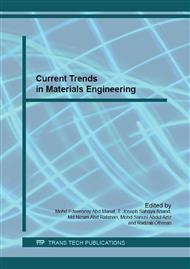[1]
R. Dimitriou, E. Jones, D. McGonagle, P.V. Giannoudis, Bone regeneration: current concepts and future directions, BMC Medicine 9 (2011) 1-10.
DOI: 10.1186/1741-7015-9-66
Google Scholar
[2]
J.R. Jones, L.L. Hench, Regeneration of trabecular bone using porous ceramics, Curr. Opin. Solid State Mater. Sci. 7 (2003) 301-307.
DOI: 10.1016/j.cossms.2003.09.012
Google Scholar
[3]
M. Pilia, T. Guda, M. Appleford, Development of composite scaffolds for load-bearing segmental bone defects, Biomed Res. Int. 2013 (2013).
DOI: 10.21236/ada616641
Google Scholar
[4]
M. Navarro, A. Michiardi, O. Castaño, J.A. Planell, Biomaterials in orthopaedics, J. R. Soc. Interface 5 (2008) 1137-1158.
DOI: 10.1098/rsif.2008.0151
Google Scholar
[5]
A. Oryan, S. Alidadi, A. Moshiri, N. Maffulli, Bone regenerative medicine: classic options, novel strategies, and future directions, J. Orthop. Surg. Res. 9 (2014) 18.
DOI: 10.1186/1749-799x-9-18
Google Scholar
[6]
J.F. Keating, M.M. Mcqueen, Substitutes for autologous bone graft in orthopaedic trauma, J. Bone Joint Surg. Br. 83 (2001) 3-8.
DOI: 10.1302/0301-620x.83b1.0830003
Google Scholar
[7]
N.A. Barakat, K.A. Khalil, F.A. Sheikh, A.M. Omran, B. Gaihre, S.M. Khil, H.Y. Kim, Physiochemical characterizations of hydroxyapatite extracted from bovine bones by three different methods: Extraction of biologically desirable HAp, Mater. Sci. Eng. C. 28 (2008).
DOI: 10.1016/j.msec.2008.03.003
Google Scholar
[8]
J. Park, R.S. Lakes, Biomaterials: An Introduction, third ed., Springer Science & Business Media, (2007).
Google Scholar
[9]
F.J.O. Brien, Biomaterials & scaffolds for tissue engineering, Mater. Today 14 (2011) 88-95.
Google Scholar
[10]
P.V. Giannoudis, H. Dinopoulos, E. Tsiridis, Bone substitutes: an update, Injury 36 (2005) S20–S27.
DOI: 10.1016/j.injury.2005.07.029
Google Scholar
[11]
N.M. Alves, I.B. Leonor, H.S. Azevedo, R.L. Reis, J.F. Mano, Designing biomaterials based on biomineralization of bone, J. Mater. Chem. 20 (2010) 2911.
DOI: 10.1039/b910960a
Google Scholar
[12]
M. Maruta, S. Matsuya, S. Nakamura, K. Ishikawa, Fabrication of low-crystalline carbonate apatite foam bone replacement based on phase transformation of calcite foam, Dent. Mater. J. 30 (2011) 14-20.
DOI: 10.4012/dmj.2010-087
Google Scholar
[13]
N.M. Nazir, D. Mohamad, Biocompatibility of in house β-tricalcium phosphate ceramics with normal human osteoblast cell, J. Eng. Sci. Technol. 7 (2012) 169-176.
Google Scholar
[14]
M. Vallet-Regi, Bio-Ceramics with Clinical Applications. John Wiley & Sons, UK, (2014).
Google Scholar
[15]
M. Bohner, Calcium orthophosphates in medicine: From ceramics to calcium phosphate cements, Injury 31 (2000) D37-D47.
DOI: 10.1016/s0020-1383(00)80022-4
Google Scholar


